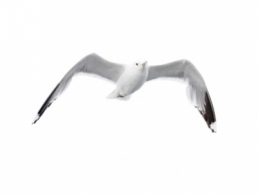
Gulls Description
Gulls are very intelligent seabirds that thrive in areas of human activity. Some individuals enjoy the sights and sounds associated with the birds while most consider them unwanted nuisances.
Massachusetts is home to a variety of gulls, but the most commonly seen are the ring-billed, herring, great black-backed, and laughing gulls.
Gulls Appearance
Ring-billed Gull
- Smallest of our Common Gulls (17.5”)
- Gray Back
- Gray Wings with Black Tips
- White Head
- Yellowish Legs
- Bill with Dark Band near Tip
Herring Gull
- 25 inches Tall
- Gray Back
- Gray Wings with Black Tips
- White Head
- Flesh Colored Legs
- Yellow Bill with Red Spot on Bottom near Tip
Great Black-backed Gull
- Largest of Common Gulls (30”)
- Black Back & Wings
- White Head
- Pale, Flesh-Colored Legs
- Yellow Bill with Red Spot on Bottom near Tip
Laughing Gull
- 16.5 inches Tall
- Black Head
- Red Bill
- White Neck & Breast
- Gray Back
- Black Tail
Gulls Habitat
Gulls are suited to life along shorelines and coastal waters, but are often seen in garbage dumps, on boardwalks, in parking lots, on rooftops, and wherever people feed them. These clever birds will return to wherever they find food consistently available.
Sometimes, gulls are found living inland in farmer’s crops and residential areas. During stormy weather, large numbers often congregate on fields, freshwater lakes, and reservoirs. At night, gulls retreat to communal roosts on coastal islands or in open water on lakes and at sea.
Problems Gulls Can Cause
Gulls generally avoid entering buildings. These birds do not hesitate to fly into yards or public spaces where food is available. Gulls that are not fazed by human presence may even be bold enough to steal food from picnickers or people eating meals on patios or outdoor cafes. Wild gulls prefer to nest in colonies on gravely beaches. The birds have also been seen nesting on rooftops in urban areas, as well, where the most damage is done.
The Damage Gulls Can Cause
When gulls nest on rooftops or chimneys, they can damage air filters, clog drains, and corrode metal equipment and paint finishes with their feces. Nesting gulls have also been known to dive-bomb people and pets!
Common diseases carried by gulls include:
- Salmonella
- Campylobacter
- Cryptosporidium
- Giardia
- E. Coli
In areas with beaches and boardwalks, gulls become nuisances when they aggressively steal food and defecate indiscriminately.
Gull Trapping and Removal
Seabirds are federally protected under the Migratory Bird Treaty Act, which prohibits individuals from hunting, trapping, removing, or interfering with nests of gulls without federal permits. Individuals should call Critter Control of Boston to assist in the proper methods of removal for gulls.
Gull Control and Safety
There are many approaches an individual can take to keep gulls away and limit the damages they can create. Enforcing feeding restrictions and removing access to other sources of food are two of the most effective ways to control gull presence. When gulls roost on rooftops and chimneys, installing bird spikes can be an efficient deterrent.
Get rid of your gull problem today!




